|
FAQs on Betta Diseases: Diagnosis 3
Related Articles:
Betta Diseases,
Betta Systems,
Anabantoids/Gouramis &
Relatives,
Betta splendens/Siamese Fighting Fish,
Improved (Better?) Products for Bettas!,
Related FAQs:
Determining/Diagnosing
1,
Disease Diagnosing 2,
Disease Diagnosing 4,
Disease
Diagnosing 5,
Betta Disease 1,
Betta Disease 2,
Betta Disease 3,
Betta Disease 4,
Betta Disease 5,
Betta Disease 6,
Betta Disease 7,
Betta Disease 8,
Betta Disease 9,
Betta Disease 10,
Betta Disease 11,
Betta Disease 12,
Betta Disease 13,
Betta Disease 14,
Betta Disease 15,
Betta Disease 16,
Betta Disease 17,
Betta Disease 18 ,
Betta Disease 19,
Betta Disease 20,
Betta Disease 21
Betta Health 22,
Betta Health 23,
Betta Health 24,
Betta Health 25,
Betta Health 26,
Betta Health 28,
Betta Health 29,
Betta Health 30,
Betta Health 31,
Betta Disease
Causes/Etiologies: Determining/Diagnosing,
Environmental (By far the largest cat.),
Nutritional,
Viral/Cancer,
Infectious (Bacterial, Fungal) ,
Parasitic:
Ich/White Spot,
Velvet;
Senescence/Old Age,
Cures/Curatives/Treatments,
FAQs on Betta Medicines:
Betta Medicines period,
Antibiotics/Antibacterials,
Anti-Protozoals (Metronidazole, eSHa...),
Copper,
Formalin,
Malachite Green,
Anthelminthics,
Organophosphates,
Salts,
All Other Betta Med.s,
|
|
 |
Betta Success
Doing what it takes to keep Bettas healthy long-term
by Robert (Bob) Fenner
|
|
Betta; investigation re hlth., beh.
9/11/18
Hi,
<Sav>
My male Betta is about a year old with long flowing fins. At least he
did, he keeps eating them. So I started him in a bowl about 9 months
ago, and noticed he was sad.
<Yes; Bettas need a heated, filtered world of a few gallons volume>
I put him in a 10 gallon tank by himself at first after 3 months. Then,
I added 3 ADFs. All was well until 2 of them died in June, one from
malnutrition I think and the other because the tank water got dirty as
the other decomposed (I was on vacation for 3 days). The last frog
survived and once I cleaned the tank and water I put them together in
the tank. The frog started chasing my Betta around, nipping his tail.
Then I noticed the Betta biting his own tail. I was told by a friend to
put more frogs in the tank, so the remaining frog would leave my Betta
alone.
<Sensible>
Well his tail bites got so severe from his own stressful biting I
decided to get a tank separator. The frog is on one third side, the
Betta has two thirds to himself. It's been about a week and a half and
I'm noticing more bite rips in his tail. The water parameters are safe
for both of them, no ammonia.
<Nor nitrite... how much nitrate? Water hardness, pH? Temperature...
steady, high? What foods are you using?>
The two are separated. There are plenty of plants and huts for my Betta
to hide in.
<Ah, good>
I cant understand why he'd still be stressed! All of these events
happened over months, not all in one week. There are no back to back
factors of stress to cause this. I just really don't want my Betta to
eat his tail away. Please help me if you can!
Sincerely, Savannah
<Please respond to my questions above, and send along a cropped pic of
all.
Bob Fenner>
Re Betta <39 megs!> 9/13/18
<You've crashed our ISP server... PLEASE see our file size requirements...
hundreds of Kbytes... B>
Re: Betta 9/13/18
Are these okay? Does the whole email have to be less than 500kb or just
each picture? I'm sorry for the inconvenience, I wasn't clear on the
instructions.
Savannah
<Ah, yes; these are fine; thank you>
Hi,
I'm responding with all the answers to your questions. The temperature stays
steady usually, give or take one or two degrees.
<Good>
Their tank is heated
and filtered.
<Very good>
The nitrate is up, but it is time to do my weekly water change which I am about
to do. The nitrate is usually steady, but I admit I haven't seen it like before.
<Do strive to keep below 20 ppm>
The pH is 7.6, ammonia is 0, nitrite is 0, and nitrate is 20. The picture makes
it look darker. I have attached pictures of the food, the water tests as of now,
the tank, my Betta, and the temp.
The tank looks more roomy than it actually is.
Thank you, Savannah
<I would add a bit of fresh, or frozen food to the diet; perhaps just
frozen/defrosted brine shrimp every other day. Otherwise, time going by should
find improvement here Sav. BobF>
|
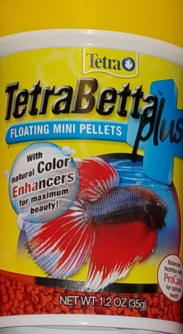 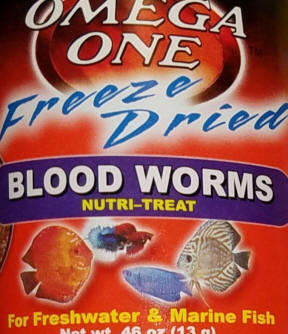
 |
|
My Betta; /Sav 9/19/18
Hi,
I emailed a few days ago about my Betta and followed it up with pictures after
asked to. I haven't received any word back yet and I was wondering if you found
any answers. My Betta ripped his tail yet again. I'm really worried about his
safety. The rips are getting close to his body.
Thank you, Savannah
<Yes Savannah; I did respond... Our corr. is archived here:
http://wetwebmedia.com/FWSubWebIndex/fwdailyfaqs.htm
Scroll down... Bob Fenner>
|
|
Betta fish 5/25/18
Hi WetWebMedia
I don't suppose you could identify this possible Betta disease? Please see
attached images. Black band around body appeared gradually
<As in days, weeks; not hours I take it>
and fish appeared well so initially I was not concerned. Its now has a grey
sheen to it so I am getting slightly worried.
Best wishes
Jemma
<Well; could be from mechanical injury (somehow) or genetic expression...
Not any parasite or infectious disease I've encountered. There is no "therapy",
treatment for such; just your ongoing good care. Bob Fenner>
|
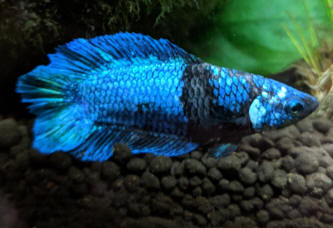 |
|
Betta fish /Neale
5/26/18
Hi WetWebMedia
I don't suppose you could identify this possible Betta disease? Please see
attached images. Black band around body appeared gradually and fish appeared
well so initially I was not concerned. Its now has a grey sheen to it so I am
getting slightly worried.
Best wishes
Jemma
<Really difficult to diagnose this. These dark coloured regions do develop on
fish occasionally, and while they might indicate nerve damage from some physical
cause, they can also be related to other types of problems.
Non-zero ammonia can cause burns, for example. There are also some external
parasites, such as Costia, that cause excessive slime to develop on a fish,
resulting in off-white to grey patches. The best advice is to review aquarium
conditions (especially temperature and water quality) first of all, and maybe
medicate as per Costia to see if that helps. Cheers, Neale.>
Re: Betta fish
5/28/18
thank you for your response. i will try the Epsom salt and see what happens
thanks again!
<Welcome, and good luck. Neale.>
|
Sick Betta (RMF, any better guesses?)<<None>>
4/21/18
Thank you for the opportunity to ask you about my sick Betta. I have a
female Betta that has developed a whitish film first on her
sides and now on the top of her head and gill plates. She has a
good appetite, puts
forward enthusiasm when she sees me, but otherwise is not herself,
depressed and not swimming around as usual, she is not flashing or
scratching, her fins are clamped most of the time. She is in an
established, filtered, heated bare bottom tank (I think it's a 3 gal)
with weekly water changes. There is an air bubbler and two live
plants in the tank. The film on her seems flat not real poufy or cottony
and as far as I can tell does not seem slimy, it's just a film that I
know is not normal.
She holds her anal fins close to her body. Your thoughts are greatly
appreciated! Sincerely, Tina
<Hello Tina. Assuming good water quality and adequate heat, and no
evidence of classic Whitespot (such as salt grain speckles and
persistent scratching), my mind is turning towards Costia, sometimes
called Slime Disease or Ichthyobodo. It's relatively easy to treat if
caught early, but can become more stubborn with time. It's a protozoan
parasite a bit like Whitespot that causes the skin to become cloudy with
mucous. Often the cloudiness surrounds the scales, almost like mortar
around bricks.
http://www.wetwebmedia.com/fwsubwebindex/CostiaF.htm
Many anti-Whitespot medications will work against Costia (I like eSHa
2000) but more often than not a second course is needed because Costia
does seem to be quite stubborn and difficult to shift. The classic
remedy was
formalin, but that's somewhat less widely used nowadays because it can
be toxic, to both fish and aquarist! Hope this helps, Neale.>
Betta sorority blues ... Mysterious female Betta losses
4/9/18
Hi there WWM folks …
I am an avid (freshwater) aquarist with an addiction to all things
aquatic (~20 or so tanks running at any given time), but these Betta
girls are giving me a heck of a time!
<Oh?>
I recently decided to break up one of my Acara breeding pairs due to
that all-too-common “way too many darned babies to grow out” disease,
which left me with an empty, well-established, moderately-planted tank
to play with.
<Understood!>
While shopping for filter media at the local big-box store, a handful of
nice-looking female Bettas caught my eye, and I ended up bringing home
six of them that appeared healthy to attempt my first sorority. I
drip-acclimated them over the course of an hour, then netted them out of
those horrid cups they’re sold in and added them all at the same time.
After watching them for about an hour to assure that no undue bullying
was happening (mature Anubias do wonders for breaking line of sight!), I
turned the lights out to let them rest. I don’t know if the variety
matters, but there was one crown tail, one Dumbo ear, and four veiltail.
<Some people do report different aggression levels in some varieties,
but I don't think it's a particularly significant factor.>
Tank parameters when the fish were added were pH 7.2, dH 4, 0
ammonia/nitrite, and 5 ppm nitrate (I usually keep NO3 around 15-20 for
the plants, but when adding new fish I like to keep it a bit lower).
<All sounds fine.>
The tank had been given a 50% water change and deep gravel vacuum after
its former occupants were moved, and had been empty for less than 8
hours before the fish were added. It is filtered with a 200 gph HOB
filter and heated to a constant 25C. I also tossed in a few (3-5) small
catalpa leaves because I planned to add a small school of Otocinclus
once my LFS got them back in stock.
<Right.>
When I awoke the next morning all of the poor girls were recently
deceased — and I say ‘recently' because 1) they had been added less than
12 hours earlier, and 2) the tank parameters were STILL fine (0
ammonia/nitrite, although nitrate had inched up a bit to between 10 and
20 ppm). 5 of the 6 had no visible signs of disease (other than being
dead, that is!) and the last, who had wedged herself under a piece of
wood and thus took me the longest to find, was covered in white fuzz.
<Oh dear. White fuzz, if distinctly fluffy, is usually fungus.
Columnaris, or Mouth Fungus, tends to be less like threads and more like
slimy patches or spots, though with more three-dimensional depth than
typical Finrot. They are difficult to tell apart to be sure, but true
Fungus usually has that cotton wool appearance that Columnaris lacks.>
The rapid decimation of the livestock coupled with the white fuzz caused
me to suspect Columnaris, so I gravel vac’d and drained the tank
completely, refilled, and nuked the system with Kanamycin +
Nitrofurazone according to the package directions.
<Understood. But I would be aware of the fact Columnaris, as well as
Finrot and Fungus, are to a great extent triggered by environmental
stress. Water changes are not a bad idea, of course, provided inbound
water chemistry matches that of the water being taken out. Similarly,
taking apart a tank for a deep clean is fine, but only if you keep the
filter working 100%.>
Once the treatment was complete, I vacuumed, drained, refilled, and
re-cycled the tank with plain ammonia.
<Was the tank cycled before the Bettas were added? If so, and assuming
you kept the filter media alive while cleaning the tank, adding ammonia
was not required here, and potentially another source of water
pollution.>
I then added a trio of panda corys that had been hanging out in my
albino Cory breeding tank just to keep the nitrifying bacteria fed.
<Okay; but do bear in mind these catfish don't like very warm water,
whereas Bettas do, so while 25 C/77 F might suit both, it's at the top
end of what C. panda approves of.>
About a week later, being a glutton for punishment, I decided to give
the sorority another go.
<How were the Corydoras? What were the ammonia and/or nitrite readings
at this point? I would NOT be adding additional fish to this tank
without knowing that the (re-)cycling process of your aquarium was
complete, and that the initial batch of fish (i.e., the catfish) were
thriving.>
This time, I bought eight veiltail juveniles (~2 cm) from a different
store, figuring that the correspondingly lower bioload couldn’t hurt and
letting the fish grow up together might keep bullying to a minimum.
<Yes.>
I removed the corys (who were, and still are, healthy), drip-acclimated
the Bettas as before, and added them to the tank with virtually the same
parameters as above.
<Understood.>
By the next morning, I had lost two of the eight; not good, but not as
bad as before. Once again, the dead fish had no visible signs of
significant damage or disease and water parameters were normal as above.
A day later, I was down to three (water still fine!); and the next day
only two remained. Again, no marks on the bodies, and the survivors were
behaving normally and appeared healthy. I am hoping that they will
remain so tomorrow, but I’m not holding my breath.
What am I doing wrong? Is there some secret to Betta sororities that I
am missing?
<I would first try and establish if the water chemistry in your tank is
very different to that of the pet store. If one has soft water and the
other hard, that can be an issue. Similarly, is your tank similar in
terms of temperature and water current strength? I'd probably let the
new tank settle for another couple of weeks before adding any more fish.
Let's be sure the tank is settled. I would not be adding any medicine --
unless the Corydoras panda got sick -- but instead focus on optimising
living conditions. Remember, Fungus, Finrot and likely Columnaris are
sitting about in all fish tanks, but only become dangerous when fish are
damaged or stressed. It's not like you can eliminate them from your
aquarium permanently. Their spores are in the air, and on plants and new
fish, and eventually will find their way into your tank, even after
using antibiotics.>
Should I just treat the tank with a broad-spectrum antibiotic when I add
them, as a preventative? Please help!
<See above.>
Thanks in advance,
Linda
<Most welcome, Neale.>
Re: Betta sorority blues ... 4/10/18
Hello again Neale, and thank you for the quick reply!
<No problem.>
I have to apologize for my previous email … it was written while I was
up past my bedtime, distraught from finding dead fish. After re-reading
it with your reply this morning, I realized that I’d somehow forgotten
to include even the tank volume ... talk about scatterbrained! Anyway, I
think I wasn’t completely clear about some of the details initially. I
re-cycled the (empty) tank with ammonia after the first round of Bettas
died, because the combination of Kanamycin + Nitrofurazone pretty much
crippled my biological filter (I left the bio media in during treatment
because I wanted to make sure that none of the nasty bugs were hiding
out in the filter).
<The thing with most of these opportunistic bacterial infections is that
you can't really eliminate them from the system, any more than
antibiotics eliminate bacteria from our homes, cars, workplaces, etc.
All the medication is meant to do is kill the bacteria inside the sick
fish, or at least slow them down enough the fish's own immune system can
kick in. For sure the bacteria should be killed off in the aquarium, and
perhaps the filter too, but the various Aeromonas and Pseudomonas
species would be back in no time at all. Ideally, you'd remove sick fish
to a hospital tank with a chemical filter (i.e., Zeolite/ammonia remover
in an air-powered box filter or similar) so that could treat the fish
without stressing the filter bacteria. But failing that, you can remove
some filter media to a bucket and leave it there, warm and wet, until
such time as it could be put back into the main aquarium AFTER you'd
finished with the medication. That said, many aquarium medications are
filter-safe, if used correctly. As you probably know, not all
antibiotics work against all bacteria (or else we'd only need to use
penicillin in all of medical science!) so the manufacturers choose
antibiotics or antibacterials that don't seriously affect the filter
bacteria.>
I only removed the (filter floss + carbon) cartridge because it would
have adsorbed the meds.
<Correct; carbon would be unhelpful here.>
It took about a week of dosing ammonia before the filter was back up to
capacity, and I replaced the filter cartridge with a new one at this
point. The corys were added in as ‘placeholders’ for a week or so just
to keep the bacteria fed, and removed once the new Bettas were added
because I was essentially quarantining the Bettas in their display tank.
Thanks for the info about C. panda, by the way … I guess I’ll have to
stick to C. aeneus once I get the tank stabilized ...
<Corydoras aeneus and Corydoras panda are the same so far as temperature
goes, 22-25 C being ideal; of the widely traded Corydoras species,
Corydoras sterbai is the only real 'hothouse flower' seen, doing well
between 24-28 C, hence its moniker as 'the Discus aquarium Cory'. The
somewhat bigger Brochis species are tolerant of warmer water, too.>
I am happy to report that my two surviving ladies are still with us, and
so far they appear healthy; eating and swimming normally, no signs of
distress or disease.
<Good news.>
Tank parameters as of this morning were as follows:
US 29 gallon, 25 C, pH 7.2, dH 5, ammonia/nitrite 0, nitrate ~5 ppm.
<Sounds good.>
As far as how my parameters and temp/current strength compare to the pet
store conditions, these ladies were packaged in unheated cups like their
male counterparts — I did test the pH in the cups before adding them,
and all were between 7.0 and 7.4. I didn’t take the temperature, but I’d
guess that room temperature in the store was about 22-23 C, whereas my
house runs about 25 C. As far as current, the turnover is a bit over 6
times/hr and I keep the water line fairly high so that the current
doesn’t penetrate too deeply below the surface (also so the filter
doesn’t make a huge racket). I could definitely add a sponge over the
intake to slow the current a bit, if you think it would help.
<If the Bettas seem to be struggling, then diffusing the outflow of
water might well be useful -- directing the outflow at the glass wall of
the tank or through a spray bar can help. I wouldn't block the inlet
unless that was the only option -- forcing the filter to work harder
than it's designed to could shorten its life.>
The current is fairly strong right under the filter output but they
aren’t being blown around the tank or anything.
<Which sounds fine.>
The fish were drip-acclimated to the tank water over the course of about
an hour since they couldn’t really be ‘floated’ in a cup. I will
definitely check the gH of the store water next time just in case they
are using liquid rock (definitely a possibility around here, if they are
using tap water), as my water tends to be fairly soft.
<Definitely a consideration.>
What would be a reasonable time frame over which to acclimate any new
fish (in a separate quarantine tank) to a lower gH with water changes?
<Really hard to say. Some scientists reckon such adaptation actually
takes days, if not weeks. Certainly if at all possible, I'd have the new
livestock in a tank of their own with tap water similar to the retailer,
and then do, say, 20% water changes each day, until the end of the week,
by which time any differences between the quarantine tank and your own
would be trivial. Alternatively, and perhaps more practical if you don't
have a quarantine tank, is to adjust the main tank to close to tap water
across one week, add new livestock, and then adjust it back again over
the following week. Of course you'd now be exposing any existing fish to
a water chemistry change, but done slowly this isn't necessarily beyond
what they're evolved to handle. So not ideal, but better than flinging
in fish from one set of conditions to another if you suspect the water
chemistry change is severe.>
Further, should I add new fish one at a time or try to do it as a group
(again, after a reasonable quarantine period) like before?
<Oh, I'd stick to adding two one week, two the next week, that sort of
thing.>
Cheers,
Linda
<Hope this helps, Neale.>
|
Sick Betta. Do data 4/4/18
I just noticed my Betta fish has this sore on his side. I’m not sure what’s
wrong and it seems to have just appeared. Let me know what you think.
Thanks!
<Your file is an order of magnitude too large, and you've presented no data re
the system, water quality tests, tankmates, the history of your having this
animal. Send useful information. This appears to be a trauma; but from what? Bob
Fenner>
-Jordan
|
.jpeg) |
|
New male Betta with one spot 3/22/18
Hi y'all, I have a male Betta that has been in a three and a half gallon
quarantine tank for about 2 and 1/2 weeks. I just noticed, because I just
purchased a magnifying glass, a little spot on a lower fin and it shows through
on the other side. I don't know if this is Ick or something that has been there
all along and I just now noticed it. I'm sending 2 pictures,
one from each side; what do y'all think? TIA!
<Not ich, white spot disease, but a sort of "blemish" I have seen/encountered
many times.
It may well persist for the life of this fish, but is not dangerous, nor
catching for others. Bob Fenner>
New male Betta with one spot, additional 3/22/18
Because I know you will want to know, he is in a heated filtered Aquarium.
The temperature was about 77 now it's up to almost 82.
<Ah yes; had looked at this msg. before responding to the first. Cheers, Bob
Fenner>
|
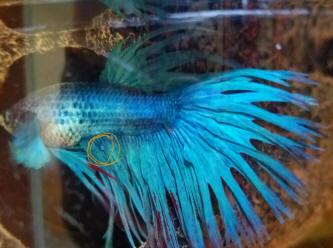
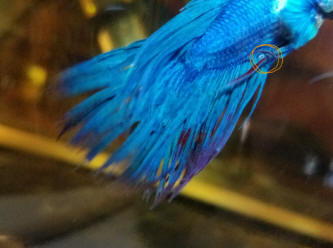 |
|
Re: New male Betta with one spot 3/22/18
Thank you! You all need to have the award for the fastest turnaround time for
questions answered.
<Heee! We aim to please. Cheers Barbara. BobF>
New male Betta with one spot /Neale
3/23/18
Hi y'all,
<Howdy.>
I have a male Betta that has been in a three and a half gallon
quarantine tank for about 2 and 1/2 weeks. I just noticed, because I
just purchased a magnifying glass, a little spot on a lower fin and it
shows through on the other side. I don't know if this is Ick...
<Nope.>
...or something that has been there all along and I just now noticed it.
<Possibly, or simply a subcutaneous cyst of some sort. It doesn't seem
to have the classic viral 'cauliflower' texture of Lymphocystis, which
is good. More than likely it's harmless, if unsightly, given its
location on the fin membrane. Sometimes tears in the fins fail to heal
properly, and become lumpy-looking. Or it may be genetic, environmental
otherwise... hard to say. Assuming the fish is otherwise behaving
normally, I'd merely observe from time to time to check it isn't getting
bigger. Benign tumours are not unknown in Bettas, but if slow growing,
and not obstructing an
essential organ, they pose minimal threat to a fish that doesn't usually
live for more than a couple years anyway.>
I'm sending 2 pictures, one from each side; what do y'all think?
Because I know you will want to know, he is in a heated filtered
Aquarium.
The temperature was about 77 now it's up to almost 82.
TIA!
<Hope this helps. Will ask for Bob F for his two penny worth, but
otherwise, I'd not fret Nice looking fish, by the way! Cheers, Neale.>
|
|
A couple of white bumps on my Betta 2/11/18
I’ve had my Betta, Ting Krit, for about 15 months. He’s always been outrageously
healthy, building bubble nests, hitting his food like a hungry bass hitting a
lure, swimming very actively. He’s in a 5.5 gallon heated, filtered tank with 1
assassin snail I added to deal with a pond snail infestation.. Temperature
stable at about 77 degrees, pH stable at 7.0 to 7.2. I check chemicals every
week and change out a gallon of water. Ammonia and nitrite always zero, Nitrate
less than 5. I used to check KH and GH as well, but they were always stable and
not a problem (I checked that with you earlier). I let his water sit in a tank
for a week before water changes with a couple of Catappa leaves in it. A couple
of weeks ago, I noticed a white spot on his left side. He still acts completely
healthy. I thought it might just be a normal discoloration. Today, I noticed
that the spot is raised, like a wart, and there seems to be one developing on
his top, well behind his head. His right side still looks normal; he’s always
had a bit of uneven coloring. I’m attaching 2 photos of his right side (one from
the top) and one of his left. His tank is growing a bit of algae. He was moved
cross-country recently, but I moved him in a large covered tub with his heater
plugged into the car plug, so he stayed warm the whole time and water stayed
clean. The only change I’ve made in the last 3 months is to start occasionally
feeding him some thawed (previously frozen) brine shrimp. Is this something to
worry about?
<I don't know specifically what these spots are... Looks too big to be a
Protozoan parasite issue... Do you feed live freshwater food/s? If this were my
fish I would not treat it with medicine/s, but just provide the good care you
detail above and be patient. Hopefully the dots/spots will resolve themselves
soon. Bob Fenner>
|
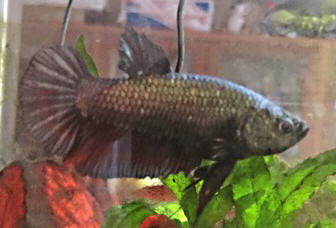
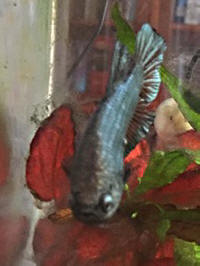 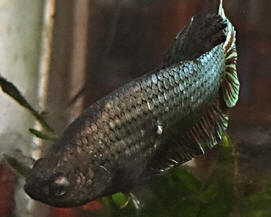 |
|
Fwd: a couple of white bumps on my Betta
2/11/18
One additional bit, the only explanation I can think of. Right before the bump
appeared, I was trying to drop a bit of brine shrimp to the Assassin snail. Ting
Krit went nuts trying to catch the brine shrimp and shoved himself against the
heater in the back of the tank. Could he have burned himself?
<Could have; yes. I am inclined to think these are blobs of body mucus... from
physical trauma/s. BobF>
Re: a couple of white bumps on my Betta 2/11/18
Thank you. That was my inclination since this spot doesn’t match anything I can
find as a parasite or disease - also he continues to act very, very healthy.
<Ah, good>
I just fed him. He immediately swims to my side of the tank when I approach and
he almost grabs the food pellets from my hand these days, Then he spends the
next few minutes patrolling the tank hoping I dropped something else. He never
rubs against things in his tank as though his side bothers him. Also, I think I
imagined the spot on his top, or it is disappearing already - today it looks
like no more than his usual uneven coloration.
I never feed live food because I’m too afraid of parasites or disease. I even
destroyed the freeze-dried blood worms I’d bought him after my biologist brother
explained all the diseases blood worms can transmit and how hard it is to be
sure that they are safe.
<Yes; I too am not a fan of these sewer fly larvae>
Ting Krit only gets dried pellets and thawed, frozen brine shrimp.
Thank you again for your time and reassurance. I’m pretty attached to the little
guy and want to keep him healthy.
<Glad to share with you. B>
|
|
My Betta Fish Hector 8/16/17
To Whom it may concern,
<Howsit Deb?>
I am concerned about my Betta fish. I got him last week like this and he is
eating and behaving normally. I know for a fact that he has a mild case of fin
rot though, but what I cannot figure out is whether the slight discoloration
(brown spot) in his face is normal or a fungal infection.
<Mmm; may be "just" stress. Perhaps simply from being moved. Do you have
measures for water quality? This system is cycled, filtered, heated?>
Please help, this is my second Betta Fish and I am doing everything I can to
understand the situation.
I appreciate it.
Sincerely,
Deb
<Need information. Bob Fenner>
|
 |
|
Re: My Betta Fish Hector 8/16/17
Dear Bob,
<Hey Deb!>
The tank is heated and filtered and I used bottled water for when I first got
him a week and a half ago.
<Mmm; what sort/s of bottled water? Is your tap/mains water real trouble?
Bettas do need some mineral, hardness... I would at least mix some (a quarter,
half?) of such bottled water with tap>
He seems to be fine since he eats (I feed him two fish pellets a day) and also
builds frequent bubble nests.
<Ahh! Good signs>
He's usually very active. I added aquarium salt in his tank about 5 days ago.
Sincerely,
Deb
<I would leave all as is then... Again, being moved is likely the cause of the
split dorsal fin, concern re facial color loss here. Treatment/s will likely
cause more harm than good. BobF>
Re: My Betta Fish Hector 8/17/17
Bob,
<Deb>
Thank you so much for your help!
- Deb
<Certainly welcome. I'd ask that you read (re-read?) this brief piece on Betta
Care:
http://www.wetwebmedia.com/fwsubwebindex/betta_splendens.htm
to set my mind at ease that I've mentioned all the basics here. Bob Fenner>
|
|
What is the treatment for this Betta? (RMF, chip in if you want!)
6/21/17
Hi, I was hoping you could help my fish?
<Certainly seems to have been through the wars!>
I will copy and paste what I wrote on a forum. So far they haven’t been much
help… was hoping you might!!
"Yes, you may have seen my other thread. *To catch you up quick-* At this point
I just need some expert eyes to take a look at him and tell me what you believe
it is and what my next plan of action. The fresh water in his hospital tank and
10 days of hard salting has absolutely helped, particularly in the reducing of
the black in his fins and behavior. He ate this morning and took a bite of a
bloodworm tonight. More progress than in weeks. He is not old.. estimate 1yr
4mos. I let it get so far because I wasn't aware of the dangers of lumps on
fish. This started I believe in January.. maybe before. He had come from very
active in his 10gal with my Pleco (little Pleco). I took him from Petco in OCT
to be a companion and because he was the suicidal looking one at the time! :( He
had some great times for awhile. Tank was vacuumed cleaned 1/3 a week and then
time started to get away from me and it changed to 50% every 2 weeks and then 3
at the end.
<Was this alongside filtration? To be clear: Bettas need filters. Maybe small,
gentle, air-powered sponge filters rather than electric canisters -- but
filtration nonetheless! Exposure to non-zero ammonia and nitrite will cause
stress, sickness and death.>
I won't allow that again!! Anyway this fish was very lively, spent most of his
time swimming and socializing, then more of his time chasing his reflection,
then most of his time at the heater. I had a hard time keeping tank warm so much
of the winter it was 75ish. I assumed for heat, but maybe was feeling lousy.
<Bettas do need steady heat. Around 25 C/77 F is good, even a smidgen above; but
consistently cooler or unstable temperatures are bad. Cold air is especially
stressful for them, hence the need to provide a lid over the aquarium to keep in
the warmth.>
This whole thing came on very very slowly. Right now I have him on Kordon fungus
rid and 1tsp per 5 gal Salt., just so it's something fighting till I know what
to buy next. (and double dose stress coat)
Questions!
1. Does this look like a case of fungus and fin rot?
<A bacterial infection (such as Finrot) seems much more likely than a fungal
infection. There are medications that treat both, such as eSHa 2000 and
Kanaplex. Avoid the tea-tree oil products (such as Melafix and Bettafix) as
these are rather unreliable -- anything marketed as having "the healing power
of..." is likely about as useful as healing crystals!>
2. Since I ran over my treatment of salt, where do I go next? Next meds?
<See above; salt isn't a treatment for anything you're dealing with here.
Indeed, it might well stress your fish.>
3. How often do I clean tank and what %?
<Assuming mature biological filtration, weekly water changes around 25% are
ample. Betta breeders who don't use filters but instead keep Bettas in jars have
to do 100% water changes every day, ensuring temperature and water chemistry
remain constant -- this just isn't practical for casual fishkeepers.>
4. As a side question, if I harvest him Mosquito Larvae and clean them, will
that help him? He LOVES them.
<Like potato chips, mosquito larvae are a perfectly acceptable snack. But they
aren't particularly nutritious, and there's some suspicion that they can bring
diseases into the aquarium, so don't use them every day. Much better to focus on
good quality flake and pellets (Tetra, Hikari and other leading brands are all
good) alongside safe live foods with no risk of carrying disease (brine shrimp,
daphnia and wingless fruit flies are reared in fish-free environments, so should
be safe).>
Current behavior: Swims around, hangs on top mostly, just started attempting to
eat, scared easily. Will extend fins, but not in full flare. Lethargy. “
Thank you!!!
<Welcome. Neale.>
|
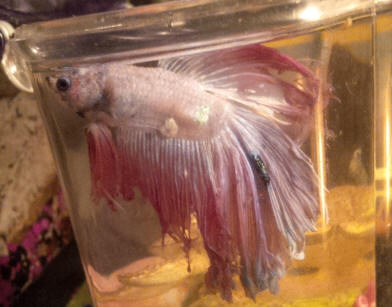 |
|
Re: What is the treatment for this Betta? (RMF, chip
in if you want!) 6/24/17
I guess what Ill do is ill make my writing blue so its not so confusing
<Eh?>
Yes, he’s a fighter!
<Indeed.>
Yes, he lived in a filtered and buffered 10 Gal with my Pleco
<Ah, the plot thinnens. Common Plecs, and possibly even Ancistrus
(Bristlenose) Plecs too, will "latch" onto the flanks of slow-moving fish to
graze on the mucous there. It may be that they're hungry, Plecs often being
given far too little food -- in the wild they're constantly ploughing through
algae and organic muck, processing massive amounts of food. Anyway, Plecs cause
horrible scars and blisters on the fish they 'attack', and because they do so at
night, many people find it hard to believe their Plec is responsible. But if you
see big blisters on the side of a fish, a hungry Plec is very likely the cause.
Seen this many, many times. If in doubt, remove the Plec to another tank (10
gallons is too small, even for an Ancistrus) and medicate as per Finrot; you
should see the Betta healing up nicely.>
Haha, it works the same with people!! Bactria and fungus aren’t to be messed
with… you want them dead! Ok, here’s the thing, you suggested Kanaplex and two
people on the forum suggested Metroplex by the same company. I told them what
you suggested and they said Kanaplex for secondary infection. I emailed Seachem
which one they’d steer me (hoping they get back to me!) But now I’m really
confused because when I looked at their products I found Paraguard which
supposedly covers everything. Now I’m really stuck!!
<Paraguard is more of a "first response" before fish get really infected wounds;
for example, after they've had a fight and their tail fins are a bit torn.
Kanaplex and MetroPlex are both good, but have different jobs. MetroPlex is
primarily used when dealing with protozoan pathogens such as Whitespot and
Hexamita, this latter extremely difficult to treat without using Metronidazole.
Kanaplex is an antibiotic containing Kanamycin, and a better bet when treating
Finrot and other bacterial infections. Make sense?>
Thank you!!!
<Most welcome. Neale.>
Re: What is the treatment for this Betta? (RMF, chip in if you want!)
6/24/17
<Ah, the plot thinnens. Common Plecs, and possibly even Ancistrus (Bristlenose)
Plecs too, will "latch" onto the flanks of slow-moving fish to graze on the
mucous there. It may be that they're hungry, Plecs often being given far too
little food -- in the wild they're constantly ploughing through algae and
organic muck, processing massive amounts of food. Anyway, Plecs cause horrible
scars and blisters on the fish they 'attack', and because they do so at night,
many people find it hard to believe their Plec is responsible. But if you see
big blisters on the side of a fish, a hungry Plec is very likely the cause. Seen
this many, many times. If in doubt, remove the Plec to another tank (10 gallons
is too small, even for an Ancistrus) and medicate as per Finrot; you should see
the Betta healing up nicely.>
OH MY GOSH, thank you!! Now that makes sense!!! I had no idea!! They used to
hang out together but I know the Pleco is VERY active at night. He throws stuff
around in the tank.. sounds like an elephant. That and too the Betta would flare
at his reflection and I know that makes them prone to fin rot in the long run!
<Paraguard is more of a "first response" before fish get really infected wounds;
for example, after they've had a fight and their tail fins are a bit torn.
Kanaplex and MetroPlex are both good, but have different jobs. MetroPlex is
primarily used when dealing with protozoan pathogens such as Whitespot and
Hexamita, this latter extremely difficult to treat without using Metronidazole.
Kanaplex is an antibiotic containing Kanamycin, and a better bet when treating
Finrot and other bacterial infections. Make sense?>
Yes, yes it does!! Thank you again!! I will order it ASAP. Finally something
makes sense :) I will update you if you don’t mind :)
<<By all means, and glad to help. Cheers, Neale.>>
Re: What is the treatment for this Betta? (RMF, chip in if you want!)
6/28/17
Hey, it's me again!! My Kanaplex just arrived *Yay*. Do you have any idea how
the HECK I dose it?
<Accurate kitchen scales, perhaps? Weigh out the amount needed for, say, 5
gallons; divide by 5, and that's how much to add to 1 gallon.>
I measured their small scoop dose (it's per 5 gallons) and 3 of those fit into
1/4tsp measuring key. How on earth do I dose that for a half gallon tank!!???
<I would NOT be keeping a Betta in a 0.5 gallon tank. As a friend of mine used
to say, "that's not an aquarium, that's a vase"! My first investment would be
something bigger, 4-5 gallons, knowing that improved living conditions WILL
improve the chances of your fish doing well/getting better.>
Also - I have a giant plastic Poland spring bottle that is 5 gal that I use to
clean tank with.. could I pre put the meds in there and then give him 100%
changes everyday? will it stay good.
<Tricky to say. Diluted medicine should be fine for a day or two, but that
assumes no further chemical reactions. Sunlight, dissolved gases, even the
minerals in drinking water are all possible sources of problems -- not to
mention any bacteria able to grow in the diluted medicine that couldn't survive
(or even get into) the sealed, concentrated medicine bottle. So without a vet
telling me this was safe, I would not do this.>
Or is it a medicine that builds up in the tank and needs to be kept as is and
not cleaned?
<Generally fish medicines break down in the aquarium very quickly, likely within
a day or so, simply because it's a warm, oxygen-rich environment with lots of
organic detritus. Hence we need to add medicine every day (or
whatever) across a period of several days.>
Thanks!! *head tree*
<Head tree? Cheers, Neale.>
Re: What is the treatment for this Betta? (RMF, chip in if you want!)
6/28/17
Haha, I got a response from Seachem as well.
<Cool.>
Thank you.
<Welcome.>
Yeah, they said do 1/5 scoop or pre mix all in 5 gal and take what I need from
it. That sounds the easiest. Of course!! I'm not keeping fishy in this box!!
He's just in there to heal and break from the filter (buffered or not, there's
still movement) .. it's working great.. he keeps on eating' :) So far so good on
Kanaplex. You shouldn't hear from me for another week or so. lol!
<Let's hope, eh?>
Hey, and yes, when you get home late, excited to see fish meds in the mail and
open the box to find complicated measurements banging your head against a tree
comes to mind.
<Indeed. Good luck, Neale.>
|
Black tiny spots on my Female/Crowntail Betta
3/1/17
I notice three very tiny black spots on my Female/Crowntail Betta's back
area(close to her head), and some black spots on her fins (left side).
These spot start appearing when I thought my fish tank had cycled. It
took a while but, now the tank is cycled. Ammonia 0, pH 7, Nitrites 0,
and Nitrates 0. I have a great filter and heater (depending on the temp
in the room it can be 78-80 degrees. The spots do not seem to hurt or
bother her.
I check to see if they were holes but, they are not. Could going
through the cycling cause these spots?
<Might well be a factor here... Can't be very sure w/o looking at
myself, perhaps sampling, observing w/ a microscope; but "dark marks"
in/on Bettas (and other fishes) are often evidence of stress,
neurological damage... and just genetic (Melanocyte) expression>
The ammonia has high for a week and then 0.
<Ahh; another stressor; often deadly>
Then the nitrites became high for a couple of days and then 0. The
Nitrates were 5.0 ppm and then 0. I used good bacteria to hurry the
cycling process. I have a 2.5 gallon tank.
<Needs to NOT be present in a cycling system; NEEDS a stable, heated,
filtered world>
When I purchase my Betta, she was very small not even a half inch long.
I thought a larger tank would be to much
for her being so young. I do plan to purchase a 5 gallon tank when she
get about 2 inches long.
I would be very thankful for your help. I look forward to hearing from
you.
<I would provide the mentioned needs and NOT treat/medicate here; as
this will only add further stress>
Thank you for taking the time to read my email.
Carolyn Bagley
<Thank you for writing so clearly, completely. Bob Fenner>
|
Betta hernia; umm; no
Hello my baby female Betta has had a long week! First her fingers split
<Fin rays.... someone traumatizing this fish>
and I did a 100% tank cleaning
<A poor idea. See WWM re "frequent partial water changes"; and "Betta Systems">
and added aquarium salt and she started to heal quickly about 5 days later
(yesterday) I notice she wasn't with her sisters at feeding time it took a
really long time to find her and when I did she was near the bottom with her
tail floating up... I figured she was constipated or it is swimming bladder
issues I placed her in a breeding cage in their tank and fasted her not that she
was in trestle in food anyhow.
I noticed today she has what looks like a hernia and I have not been able to
find any helpful information on how to treat her. any info will help! I have
attached pictures of the "hernia".
Thank you
Stacy
<And search WWM w/ the string "Betta egg bound", "Betta nutrition".
AFTER reading, if you have questions, concerns, please write back.
Bob Fenner>
|
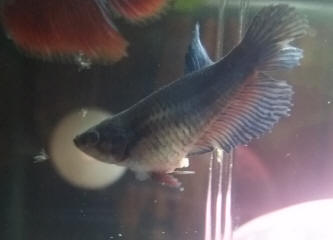
|
Betta hernia /Neale
9/10/16
Hello my baby female Betta has had a long week! First her fingers split and
I did a 100% tank cleaning and added aquarium salt and she started to heal
quickly about 5 days later (yesterday) I notice she wasn't with her sisters
at feeding time it took a really long time to find her and when I did she
was near the bottom with her tail floating up... I figured she was
constipated or it is swimming bladder issues I placed her in a breeding cage
in their tank and fasted her not that she was in trestle in food anyhow.
I noticed today she has what looks like a hernia and I have not been able to
find any helpful information on how to treat her. any info will help! I have
attached pictures of the "hernia".
Thank you
Stacy
<Hi Stacy. This isn't a hernia as such, but a prolapse of the final part of
the digestive tract. Not uncommon in fish that have been exposed to less
than perfect water conditions. Coupled with your report of Finrot (the
frayed fins) I'd be reviewing water quality and filtration. To recap the
basics: Bettas need a heated, filtered aquarium. I'd say not less than 4 to
5 gallons. Definitely not bowls! The filter should be standard biological
filter, something like an air-powered sponge or small canister is ideal.
Water quality needs to be good: zero ammonia and zero nitrite. Finrot is
almost always a sign of either fighting or poor water quality, and since
fighting isn't an explanation here, assuming your Betta is kept alone (and
it should be) then water quality is your problem. Aquarium salt isn't a
treatment for either the prolapse or the Finrot, but a reliable antibiotic
will help soothe the symptoms. Improving living conditions will be
essential. Hope this helps, Neale.>
|
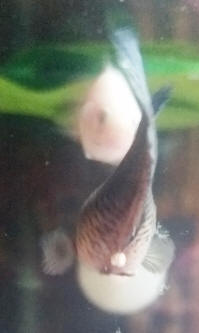 |
|
|
|

